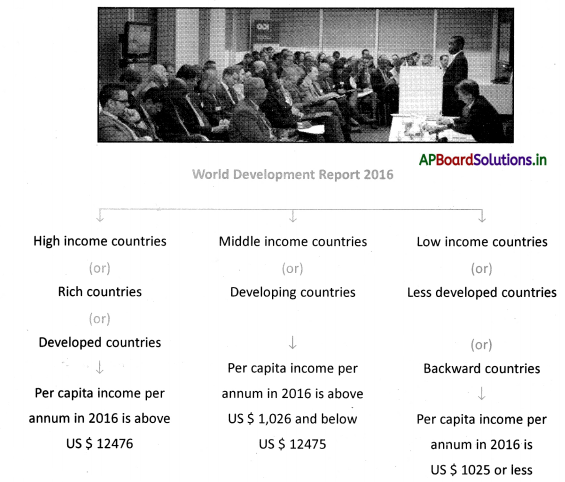Students can go through AP State Board 10th Class Social Studies Notes Chapter 2 Ideas of Development to understand and remember the concept easily.
AP State Board Syllabus 10th Class Social Studies Notes Chapter 2 Ideas of Development
→ Development involves thinking about and adevùig goals of a better life for all and more quality among all
→ All persons do not have the same notion of development.
→ Persons seek things that can fulfill their aspirations or desires.
→ At times, two persons or groups of persons may seek things that are conflicting.
→ Besides seeking more income, people also seek equal treatment, freedom, security, respect from others, and resent discrimination.
→ More income means more of all things that human beings need. c& Average income, which is the total income of the country divided by the total population is also called per capita income.
→ World Development Report brought out by the World Bank in 2013 classified the countries into 3 groups.
→ Countries with per capita income of US $ 12,600 and above per annum in 2012 are called high-income countries or rich countries,
→ Countries with a per capita income of above US $1,035 and below the US $ 12,600 per annum in 2012 are called middle-income countries.
![]()
→ Countries with a per capita income of US $1,035 or less per annum in 2012 are called low-income countries.
→ The rich countries, excluding countries of west Asia and certain other small countries, are called developed countries.
→ The goods and services or required facilities that are provided by the government or society are called public facilities.
→ Human Development Report compares the countries, the educational levels of people, their health status, and per capita income as measures of development.
→ Human Development Report 2013 is the Human Development Index ranking among the 177 countries in all.
→ Per capita income is calculated in US Dollars for all countries so that one can compare all the countries.
→ A small country in our neighborhood, Sri Lanka, is much ahead of India in every indicator of development.
→ The schooling revolution in Himachal Pradesh provided infrastructure in education, and, both the government and society complemented each other to achieve great indicators of education.
→ In the year 2005, the average spending on education by the government in Indian states was Rs. 1,049 per child, Himachal Pradesh was spending Rs. 2,005 per child.
→ Development entails a mix of goals.
→ India, a decade ago was a less developed country, and now transformed into a developing country or middle-income country.
→ Every Indian would like to see India as a developed country.
→ Per capita income: Total income of the country divided by the fatal population.
→ Human development: Comparing the countries and reporting their development based on the educational levels of people, their health status, and per capita income
→ Public facilities: The facilities, i.e., goods and services that are provided by the government or society
→ Education and health Indicators: The indicators which show the educational æd health conditions of the people like average years of schooling, life expectancy at birth, etc.
![]()
→ Development: Achieving the goals of making life better for all and bringing more equality
→ The idea of development: Sk the thing that is most important for one which fulfills his developmental goal or aspiration
→ Material things: The things that one can buy with money
→ Non-material things: The things that one cannot buy with money like equal treatment, freedom, etc.
→ High-income countries: Countries with annual per capita income of US $ 12,600 and above in 2012.
→ Middle-income Countries with per capita income of above US $ 1,035 countries and below LIS $12,600 per annum in 2012.
→ Low-income countries: Countries with per capita income of below US $ 1, 35 per annum in 2011
→ Infant Mortality Rate: Out of 1,000 live children burn, the number of children who die within one year.
→ Literacy Rate: The percentage of the literate population in the 7 years and above age group.
→ Net Attendance Rate: Out of the total number of children in the age group 6- 17 years the percentage of children attending school.
→ HDI: Human Development Index
→ Life expectancy at birth: Average expected length of life of a person at the time of birth.
![]()
→ Average years of schooling: Average number of years of education received by people that age 25 years and above.
→ Expected years of schooling: Number of years of schooling that a child at school entrance age can expect to receive given the present enrollment rates.

